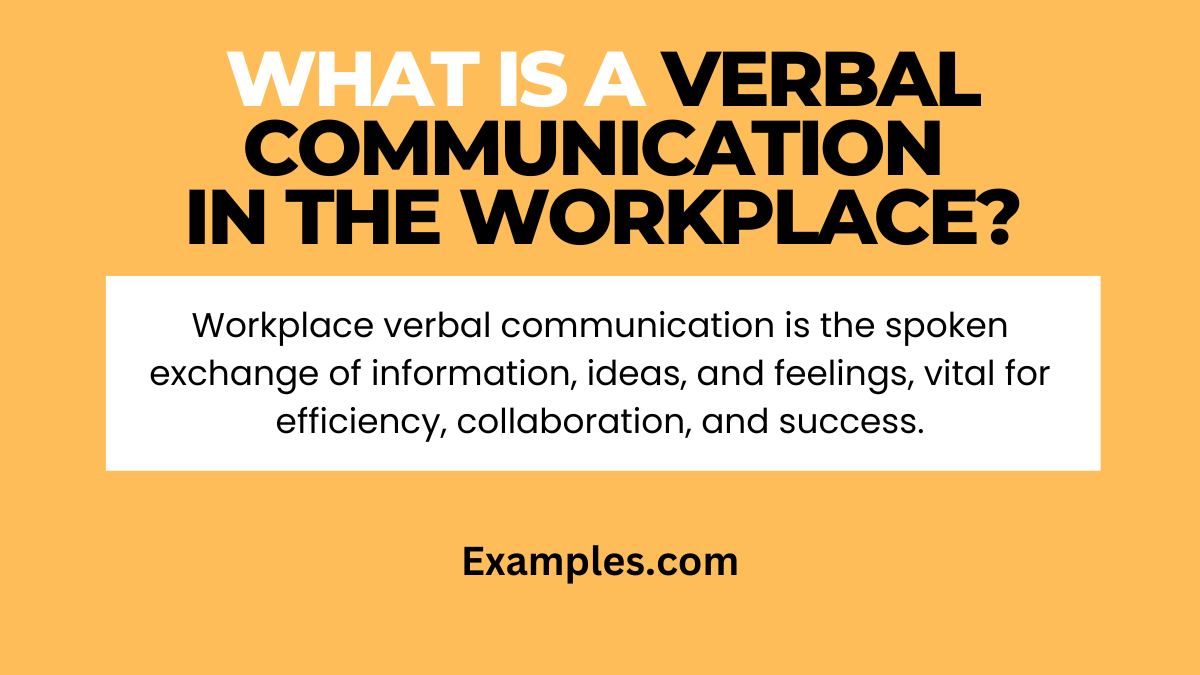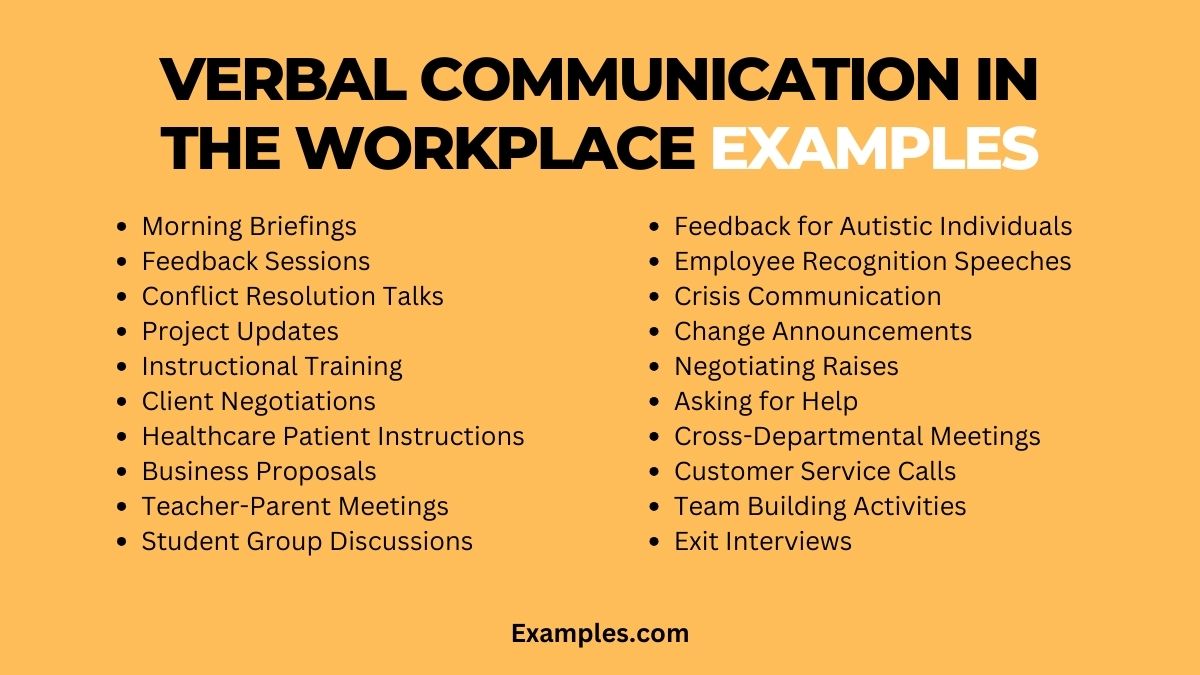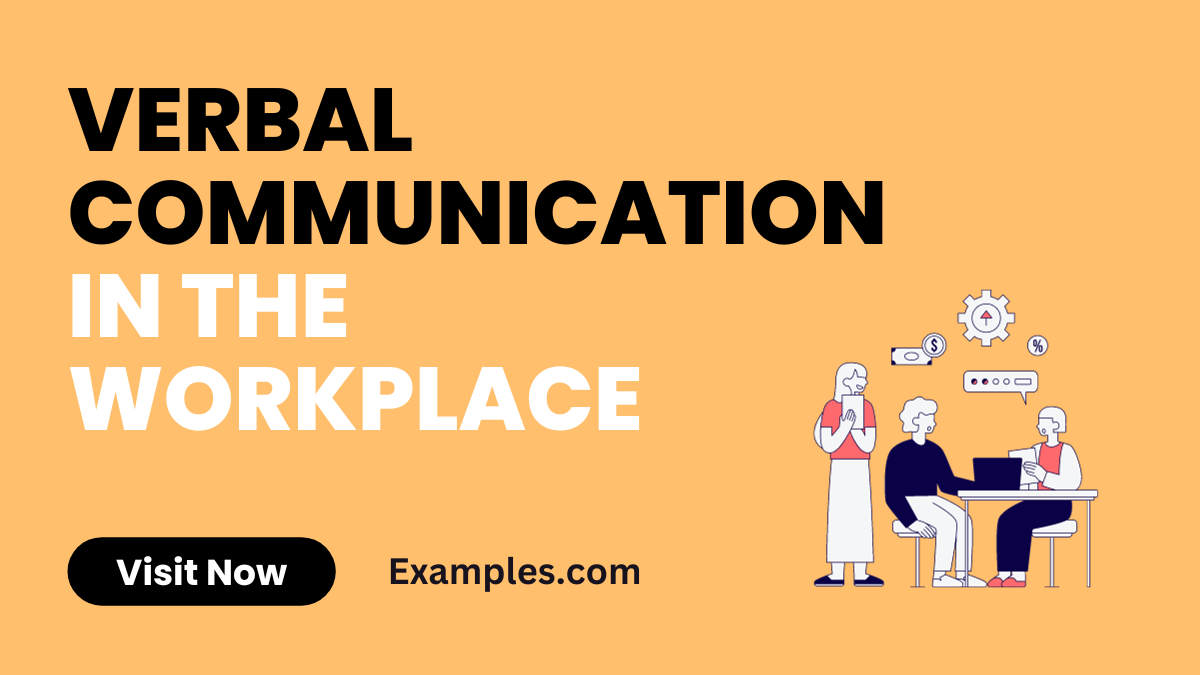19+ Verbal Communication in the Workplace Examples
Embrace the power of dialogue with our comprehensive guide on verbal communication in the workplace. This essential read illuminates how words shape our professional interactions, featuring compelling Communication Examples and strategies. Discover the art of conveying ideas, enhancing team dynamics, and fostering an environment of collaboration and respect through effective verbal exchanges. Dive deep into the nuances of workplace dialogue to unlock productivity and positive work culture.
Download Improving Verbal Communication in the Workplace FAQs PDF
What is Verbal Communication in the Workplace? – Meaning

Verbal communication in the workplace refers to the exchange of information, ideas, or feelings between individuals using spoken words. It is a pivotal element of daily interactions, from giving instructions and feedback to brainstorming and resolving conflicts. Effective verbal communication ensures that the message is clear, concise, and well-understood, promoting efficiency and harmony among colleagues. Real-world Verbal Communication Examples demonstrate its role in building relationships and driving success in various business settings.
What is the Best Example of Verbal Communication in the Workplace?

The best example of verbal communication in the workplace often involves clear, respectful, and constructive dialogue. One such Verbal Communication Technique is the regular team meeting, where members openly discuss goals, provide updates, and collaboratively solve problems. Here, active listening, positive feedback, and concise language contribute to a productive and inclusive environment. Such meetings showcase how effective verbal communication fosters understanding, boosts morale, and aligns the team towards common objectives.
20 Verbal Communication in the Workplace Examples

Discover the vital role of verbal communication in professional settings with our in-depth guide featuring 20 unique examples. Each scenario is meticulously chosen to reflect the broad spectrum of verbal interactions, from daily briefings to complex negotiations. Understand what Percent of Communication is Verbal and the intricate balance between spoken words and non-verbal cues. Dive into the Advantages and Disadvantages of Verbal Communication, recognizing how it influences productivity and workplace relationships. This exploration covers the Functions of Verbal Communication and delves into the Types of Verbal Communication, providing insights to enhance your verbal communication skills. Whether you’re in healthcare, business, education, or any field, these examples will guide you on ways to Improve Verbal Communication Skills and address specific needs, such as verbal communication for teachers, students, or individuals with autism. This collection of examples and solutions offers a practical roadmap to mastering verbal communication in various workplace scenarios, enhancing both individual and collective efficiency and harmony. Whether addressing Verbal Communication in Healthcare, navigating Verbal Communication in Business, or adapting strategies for diverse audiences like students or individuals with autism, these insights are designed to foster a more connected and productive work environment.
- Morning Briefings:
- Cause: Lack of focus or engagement.
- Fix: Implement active listening techniques and concise messaging.
- Feedback Sessions:
- Cause: Misunderstandings due to non-specific language.
- Fix: Use clear, specific examples and positive language.
- Conflict Resolution Talks:
- Cause: Emotional responses and defensive communication.
- Fix: Adopt a neutral tone and focus on problem-solving.
- Project Updates:
- Cause: Information overload or unclear instructions.
- Fix: Summarize key points and clarify objectives.
- Instructional Training:
- Cause: Complex terminology or fast-paced delivery.
- Fix: Adjust language to audience’s understanding and pace.
- Client Negotiations:
- Cause: Aggressive or passive communication styles.
- Fix: Practice assertiveness and active listening.
- Healthcare Patient Instructions:
- Cause: Medical jargon or lack of empathy.
- Fix: Use plain language and show understanding.
- Business Proposals:
- Cause: Overly technical details or lack of enthusiasm.
- Fix: Balance technicality with persuasive, engaging language.
- Teacher-Parent Meetings:
- Cause: Cultural misunderstandings or preconceptions.
- Fix: Employ cultural sensitivity and clear explanations.
- Student Group Discussions:
- Cause: Dominance of certain members or off-topic discussions.
- Fix: Establish clear roles and encourage inclusive participation.
- Feedback for Autistic Individuals:
- Cause: Sensory overload or literal interpretations.
- Fix: Provide clear, direct communication and structured environments.
- Employee Recognition Speeches:
- Cause: Generic or insincere praise.
- Fix: Personalize acknowledgements and highlight specific contributions.
- Crisis Communication:
- Cause: Panic or misinformation.
- Fix: Maintain calm, provide accurate information, and give clear instructions.
- Change Announcements:
- Cause: Resistance to change due to uncertainty.
- Fix: Explain reasons, benefits, and provide support during transitions.
- Negotiating Raises:
- Cause: Discomfort or unrealistic expectations.
- Fix: Research market rates, express value, and negotiate confidently.
- Asking for Help:
- Cause: Fear of appearing incompetent or imposing.
- Fix: Normalize seeking assistance and clarify mutual benefits.
- Cross-Departmental Meetings:
- Cause: Jargon and lack of shared knowledge.
- Fix: Use layman’s terms and build a common understanding.
- Customer Service Calls:
- Cause: Scripted responses or lack of empathy.
- Fix: Personalize interactions and actively listen to concerns.
- Team Building Activities:
- Cause: Lack of participation or enthusiasm.
- Fix: Encourage open communication and relate activities to team goals.
- Exit Interviews:
- Cause: Discomfort or unwillingness to share.
- Fix: Create a safe, open environment and encourage honest feedback.
Verbal Communication in the Workplace for Employees
Effective verbal communication is the cornerstone of success for employees in any field. It enhances teamwork, resolves conflicts, and boosts productivity. This guide highlights strategies to refine your verbal interactions, ensuring you convey your messages clearly and professionally. Understand how to tailor your communication to diverse workplace scenarios, from formal presentations to casual conversations. By incorporating techniques on how to improve Verbal Communication Skills, you’ll foster a more positive and efficient work environment.
- Providing Constructive Feedback: “Let’s start earlier next time to comfortably meet the deadline.”
- Participating in Team Meetings: “I suggest prioritizing A and B for better campaign results.”
- Handling Customer Queries: “Let me explain how we can resolve this issue for you.”
- Requesting Assistance or Clarification: “Could you please clarify the new protocol for me?”
- Negotiating Deadlines or Resources: “I’ll need two additional days for quality work. Let’s discuss.”
Verbal Communication in the Workplace for Interview
Mastering verbal communication is crucial during interviews, as it demonstrates your confidence, clarity, and professional acumen. This guide provides key insights into articulating your thoughts effectively, showcasing your qualifications, and engaging with interviewers. By understanding the nuances of verbal communication for school graduates entering the workforce or experienced professionals alike, you can significantly improve your interview performance and leave a lasting positive impression. These examples and tips are tailored to help employees and job seekers alike navigate the complexities of verbal communication, ensuring each interaction is impactful and meaningful.
- Answering Behavioral Questions: “I prioritize tasks and communicate regularly under tight deadlines.”
- Discussing Past Experiences: “I led a team of 5, increasing productivity by 20%.”
- Explaining Skills and Strengths: “My analytical skills help me make quick, data-driven decisions.”
- Addressing Weaknesses or Gaps: “I’m improving my public speaking skills through workshops.”
- Asking Insightful Questions: “What are the team dynamics and my role’s contribution to company goals?”
How Does Effective Verbal Communication in the Workplace Contribute to Team Collaboration and Productivity?
Effective verbal communication is a driving force behind successful team collaboration and productivity. It bridges gaps and aligns team efforts towards common goals, proving the importance of verbal communication in achieving collective success.
- Establishes Clear Objectives: Clear communication sets precise goals for the team, ensuring everyone understands their roles and responsibilities.
- Enhances Problem-Solving: Open dialogue fosters creative solutions, allowing teams to address challenges efficiently.
- Builds Trust and Rapport: Regular, honest communication builds trust, crucial for collaboration and a positive workplace environment.
- Facilitates Feedback and Growth: Constructive feedback helps individuals and teams grow and improve, leading to increased productivity.
- Ensures Agile Adaptation: In fast-paced environments, effective communication allows teams to quickly adapt to changes and new information.
What are the Components of Successful Verbal Communication within a Workplace?
Successful Verbal Communication in the Workplace is multifaceted, involving several key components that contribute to its effectiveness. Understanding why you need verbal communication skills is fundamental for personal and organizational growth. Incorporating these components will not only benefit traditional workplace settings but also enhance verbal communication for students, individuals with autism, and professionals in specialized fields like law enforcement, where clear, effective communication is critical.
- Clarity and Conciseness: Clear, direct communication prevents misunderstandings and keeps messages impactful.
- Tone and Empathy: The way messages are delivered can significantly affect how they’re received. A respectful, empathetic tone is crucial.
- Active Listening: Successful communication isn’t just about speaking well; it’s also about listening actively and understanding others’ perspectives.
- Non-Verbal Cues: Body language, facial expressions, and eye contact complement verbal messages and can enhance understanding.
- Feedback Mechanism: Providing and receiving feedback is essential for continuous improvement and ensuring that messages are understood as intended.
How Can Verbal Communication Lead to Workplace Success?
Effective verbal communication fosters understanding, trust, and collaboration, crucial for achieving workplace success and adhering to the rules of verbal communication.
How Effective Verbal Communication is Used in a Workplace Setting?
In workplaces, effective verbal communication is used for clear instructions, constructive feedback, and efficient teamwork, balancing verbal vs written communication for maximum impact.
How Can Verbal Communication Skills Be Improved in the Workplace?
Improving verbal communication in the workplace involves active listening, practicing clarity, and understanding the nuances of verbal vs oral communication to enhance interactions.
In conclusion, verbal communication in the workplace is a linchpin for effective collaboration and organizational success. Through illustrative examples and an exploration of its effects, we’ve highlighted its pivotal role. Identifying signs of breakdowns in communication is crucial. Fortunately, by implementing practical solutions and fostering a culture of open dialogue, organizations can rectify issues, enhance productivity, and build stronger, more cohesive teams.



